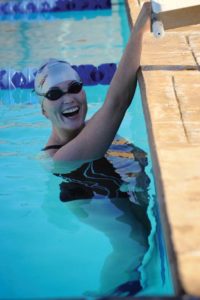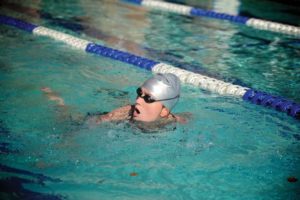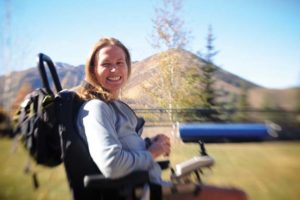
In the spring of 2000, Amanda Walton was at the top of her game. She had just completed her sophomore year at Yale University, had been named First Team All-American in field hockey and received First Team All-Ivy honors in both field hockey and lacrosse. It was quite an achievement for a sophomore starter, one that followed on the heels of being named Ivy League Rookie of the Year in both field hockey and lacrosse her freshman year—making her the second person in Ivy League history to be named Rookie of the Year in both sports.
“She is probably one of the best female athletes ever to come to Yale,” said Ainslee Lamb, who was Walton’s assistant field hockey coach in her first two years at Yale. “She was breaking career records in her sophomore year.”
Just days after finishing her second year, Walton’s life was shattered in a single instant when her Saab was struck at 80 mph by a driver fleeing police in a high-speed chase through a residential neighborhood in Meriden, Connecticut. It was May 28, 2000. The Jaws of Life extracted her from her crumpled vehicle and she was heli-lifted to St. Francis Hospital Intensive Care Unit in Hartford, Connecticut, where she lay for the next month and a half in a deep coma.
When asked about her injuries, Walton cites massive internal bleeding, a shattered pelvis, a broken right foot, a sprained left foot and the severe brain trauma that marks the magnitude of what she struggles with now in her daily life. “I broke my brain,” she said quite simply.
In medical terms, her injury is defined as traumatic brain injury (TBI). Specifically, Walton suffered diffuse axonal injury (DAI), which involves bleeding all over the brain (diffuse, meaning that the trauma involved more than one area of the brain). The outcome is often prolonged coma, with over 90 percent of patients with severe DAI never regaining consciousness. It is a potentially devastating injury that can cause a wide range of functional changes affecting thinking, sensation, motor skills and language.
proving the impossible . . . I love breaking records.”
The fact that Walton survived at all is a miracle. The way her smile infects her entire person, flashing into the corners of her eyes and overtaking her face, is proof of her enduring spirit. It is a force much larger than any medical terms or definitions or standard data.
Walton doesn’t believe in statistics, an extension of what she calls her “I don’t believe in not believing” philosophy. “Nobody ever said, ‘This is where you are going to be and no more,’” she said. “And if they did, I would have said: ‘Take another look. You don’t know,’ … and this may sound a little cocky, but, ‘Take another look. You don’t know who you are dealing with.’”

And clearly, few really knew whom they were dealing with. Walton is still breaking records. She prides herself on doing what people believe to be impossible and feels that this is a central component to her recovery. “I think part of my journey is about proving the impossible. I love breaking records. And that is what is keeping my ability to smile so alive.”
out of my vocabulary, which I think leads to my ability
to have a positive attitude. Because ‘why’ does not help.
You know, ‘Why did this happen to me?’
I don’t ask. I look past that.”
It has been a long road for Walton. On March 10, 2009, when she and I first sat down together, she said that it had taken her almost six years to be able to cry. Some of it was medical, due to the nerve tearing and chemical damage associated with her brain trauma. After nearly six years, she had a lot of grieving to do.
“I can say that I didn’t really ‘come to’ until three years after the accident. It took me awhile to process what happened to me and, I guess, for my insides to realize what happened to me. And at that point, my insides became severely depressed. Laughter, and my brother Dave, played a big role in pulling me out of those bouts of depression.”
The sun definitely helps, she added with a smile.
It is part of what motivated her move to the Wood River Valley. Sunshine. It’s not just the weather—it’s a state of mind that drew her to heal in Ketchum. “Everyone here is very helpful and questioning, wanting to know how they can help,” she said, “whereas in Boston they would walk right by.”
Walton thinks that life is a journey, and she wants hers to be “an adventure,” which is a journey with a positive twist. Her mantra: I am life.
“What I actually love about this journey that I’m on now is focusing on my being. It was always secondary to my athletics and now it has to be first,” Walton said. “I am proud of myself. And I did not think I would ever say that.”
It wasn’t always like this. Walton’s physical challenges and depression (a chemical byproduct of her DAI trauma, defined as rapid-cycling bipolarity and essentially beyond her control) are not easily overcome. Admittedly, it has been a difficult road. Incredibly difficult. “The biggest challenge is my independence. I used to be so, so independent, and now I need somebody with me or near me 24/7. And just knowing that really pains me.”

She credits her doctor of almost nine years, local Randy Hermann, M.D., as providing an essential insight during one of these critical times. “I am an athlete,” she said, “so any metaphor that has to do with athletics grabs my heart and soul. And he said, ‘If you have something that is causing you anxiety, just sideline it.’ And since he said that last March, I have done it and it has helped me tremendously. I don’t dwell on things that aren’t pertinent in my life or that only cause anxiety.”
Her dreams center around being self-sufficient and her desire to be an inspiration for others. “I have an enormous amount of hope that I can regain my independence. And that I can continue proving the impossible as possible. I have gone above and beyond expectations. I had essentially died in the hospital. I hadn’t died, but any time a doctor came over, my family thought he or she was coming over to tell them of my death. And now I live alone. And that is something I am very proud of. And I can get around town on my own. It is my ATV chair and I can get around in the snow,” she said of her all-terrain, self-guided wheelchair. “That is what I do to enliven myself and to awaken my soul.”
Walton’s determination is palpable. You can feel it, almost as a physical element to her presence. It is what drives her to pilot her wheelchair through rain, sleet or snow, across town and uphill to Zenergy to meet her swim coach and trainer Karen Morrison for their bi-weekly training sessions. She doesn’t get a ride. She drives herself. And arrives, according to Morrison, with a smile on her face, ready to work hard.
Morrison said she began by floating Walton, just holding her breath in the water. “I started floating her toward the steps and then she started swimming. And now she does 800 yards two times per week, using just one arm and one leg. … And now what she is, is the athlete that she used to be. It has gone from therapeutic to being an athlete who is in training.”
Walton’s view is characteristically more straightforward. “I used to be a field hockey and lacrosse player,” she said to Morrison. “I’m now a swimmer!”
“You know, Amanda wants to be an inspiration to people,” said Morrison. “And she doesn’t realize that she already is.”
Walton’s new mantra, as of October 2009: I can do it. She says she has confidence again. The adrenaline rush of endorphins streaming through her bloodstream is a familiar and welcome addition to her life. “The fact that I’m competing again in sports, that competition is in my life again, gives me so much inspiration and drive,” she said. “I feel that I can work on training for walking. Or really, anything.”
I don’t ask that, and don’t think I have ever asked myself ‘Why can’t I do that?’”
Her goal of competing in the U.S. Paralympics Spring Swimming Nationals in San Antonio, Texas, in March 2010 is quickly becoming a reality. She plans to compete in three different races—the 50-meter, 100-meter and 200-meter freestyle—and will celebrate her 30th birthday during the week of competition. It is remarkable and inspiring. But it is not unexpected or unforeseen. Not once you know Amanda Walton.
Walton’s primary mantra, “I am life,” permeates her whole being. She contemplates moments with such depth and intensity that the final thought contains a hard, sharp clarity. Her insights are acute. Her ability for laughter is immediate. She believes intensely.
Above her desk is a watercolor painting of the sun that she completed this past summer. On it, she has inscribed a quote by Abraham Lincoln that reads: “You’re just about as happy as you make up your mind to be.”
It is a profoundly simple lesson for each of us, each and every day.

